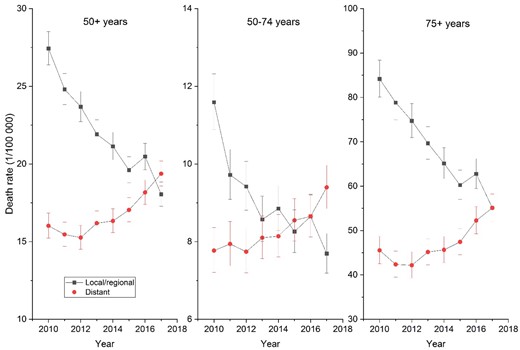-
PDF
- Split View
-
Views
-
Cite
Cite
Stacey A Fedewa, Jiemin Ma, Ahmedin Jemal, Response to Lehrer and Rheinstein, JNCI: Journal of the National Cancer Institute, Volume 112, Issue 10, October 2020, Pages 1069–1070, https://doi.org/10.1093/jnci/djaa093
Close - Share Icon Share
We thank Drs Lehrer and Rheinstein for their interest in our recent article published in the Journal. In this article, we reported that prostate cancer incidence rates continued to decline for early staged disease, whereas rates increased for regional- and distant-stage diseases following the US Preventive Services Task Force recommendations against routine prostate-specific antigen (PSA) testing for men aged 75 years and older in 2008 and for all men in 2012 (1). For example, among men who were 50 years and older, local-staged prostate cancer incidence decreased by 6.9% per year from 2007 to 2016. In contrast, regional-staged incidence statistically significantly increased by 11.1% per year from 2012 to 2016, and distant-staged prostate cancer incidence increased by 5.0% per year from 2010 to 2016. In our discussion, we state that these findings, along with previously reported stabilization of prostate cancer death rates, can inform the population of the benefits and harms of PSA testing.
Lehrer and Rheinstein examined stage-specific prostate cancer survival trends. They report that 12-month relative survival for patients diagnosed between 1998 and 2016 remained 100% for localized prostate cancer and increased from 72% to 81.4% for distant-stage disease (2). The authors state, “Our analysis confirms the recent stabilization of prostate cancer death rates after a steady decline since the early 1990s.” Further, the authors conclude, “Given the complications associated with curative treatment of prostate cancer, especially in older men, we feel that the original USPSTF recommendation against routine PSA screening was well taken.”
However, death rates, which are the number of deaths per 100 000 men in the general population, were not included in Lehrer and Rheinstein’s analyses. Previous studies have examined prostate cancer mortality through 2017, finding that overall prostate cancer mortality trend stabilized from 2013 to 2017 (3).
Here, we examined stage-specific prostate cancer death rates in the Surveillance, Epidemiology, and End Results population-based data between 2010 and 2017 with the JoinPoint regression software tool (4), shown in Figure 1. Among men aged 50 years and older, localized prostate cancer death rates declined and distant-staged prostate cancer death rates rose between 2012 and 2017. Among men aged 50–74 years, distant-staged death rates rose by 2.62% between 2010 and 2017 and by 5.54% between 2012 and 2017 among men aged 75 years and older. Data on prostate cancer incidence rates, treatment, survival, and death rates, as well as simulation modeling, can inform the population of the benefits and harms of PSA testing as well as update recommendations (5). In 2018, the US Preventive Services Task Force updated its recommendations for individualized decision making for PSA-based screening for men aged 55–69 years (6). Continued surveillance of PSA testing, prostate cancer occurrence, and outcomes is needed to inform cancer control efforts.

Stage-specific prostate cancer death rates by stage, age group, and year of diagnosis, SEER 18 (2010-2017).
References
US Preventive Services Task Force.


